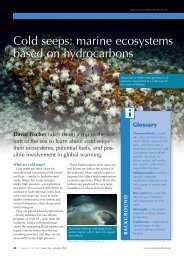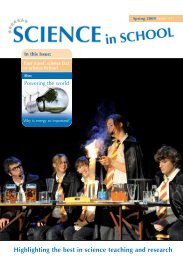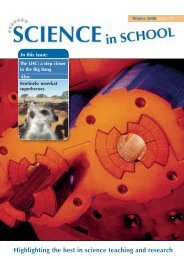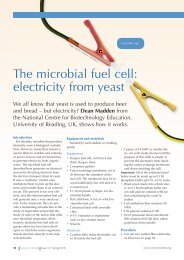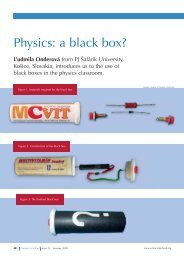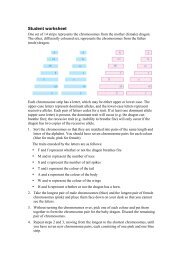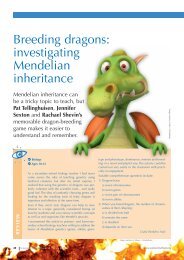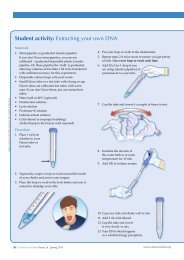What is chemiluminescence? - Science in School
What is chemiluminescence? - Science in School
What is chemiluminescence? - Science in School
Create successful ePaper yourself
Turn your PDF publications into a flip-book with our unique Google optimized e-Paper software.
Image courtesy of David Muehlheimer; image source: Wikimedia Commons<br />
Chemilum<strong>in</strong>escence<br />
of lum<strong>in</strong>ol <strong>in</strong> the<br />
laboratory<br />
<strong>What</strong> <strong>is</strong> <strong>chemilum<strong>in</strong>escence</strong>?<br />
Glow<strong>in</strong>g jellyf<strong>is</strong>h, flicker<strong>in</strong>g fireflies, fun glow sticks; Emma<br />
Welsh <strong>in</strong>troduces the beautiful and mysterious world of<br />
<strong>chemilum<strong>in</strong>escence</strong>.<br />
A firefly glow<strong>in</strong>g<br />
Image courtesy of Terry Priest; image source: Flickr<br />
Image courtesy of Erik Solheim; image source: Wikimedia Commons<br />
Glow sticks<br />
Fireflies, jellyf<strong>is</strong>h and glow<br />
sticks – one flies, one lives<br />
deep <strong>in</strong> the ocean and one<br />
provides enterta<strong>in</strong>ment <strong>in</strong> night clubs.<br />
<strong>What</strong> <strong>is</strong> the l<strong>in</strong>k? The answer <strong>is</strong> some<br />
<strong>in</strong>trigu<strong>in</strong>g chemical reactions that<br />
produce light.<br />
Chemilum<strong>in</strong>escence <strong>is</strong> the production<br />
of light from a chemical reaction.<br />
Two chemicals react to form an<br />
excited (high-energy) <strong>in</strong>termediate,<br />
which breaks down releas<strong>in</strong>g some<br />
of its energy as photons of light (see<br />
glossary for all terms <strong>in</strong> bold) to reach<br />
its ground state (see Figure 1 on page<br />
64).<br />
A + B –> AB* –> Products + Light<br />
Excited<br />
<strong>in</strong>termediate<br />
Chemilum<strong>in</strong>escent reactions do not<br />
usually release much heat, because<br />
energy <strong>is</strong> released as light <strong>in</strong>stead.<br />
Lum<strong>in</strong>ol produces a light when it<br />
reacts with an oxid<strong>is</strong><strong>in</strong>g agent; the<br />
chem<strong>is</strong>try of th<strong>is</strong> reaction <strong>is</strong> shown <strong>in</strong><br />
Box 1 (page 66).<br />
62 I <strong>Science</strong> <strong>in</strong> <strong>School</strong> I Issue 19 : Summer 2011 www.science<strong>in</strong>school.org
<strong>Science</strong> topics<br />
Image courtesy of How Stuff Works<br />
Chemilum<strong>in</strong>escence <strong>in</strong> forensics<br />
Forensic scient<strong>is</strong>ts use the reaction<br />
of lum<strong>in</strong>ol to detect blood at crime<br />
scenes. A mixture of lum<strong>in</strong>ol <strong>in</strong> a<br />
dilute solution of hydrogen peroxide<br />
<strong>is</strong> sprayed onto the area where the<br />
forensic scient<strong>is</strong>ts suspect that there<br />
<strong>is</strong> blood. The iron present <strong>in</strong> the haem<br />
unit of haemoglob<strong>in</strong> (Figure 3, page<br />
66) <strong>in</strong> the blood acts as a catalyst<br />
<strong>in</strong> the reaction described <strong>in</strong> Box 1.<br />
Us<strong>in</strong>g lum<strong>in</strong>ol at the<br />
scene of a crime<br />
The room must be dark and if blood<br />
<strong>is</strong> present, a blue glow, last<strong>in</strong>g for<br />
about 30 seconds, will be observed.<br />
The forensic <strong>in</strong>vestigators can record<br />
th<strong>is</strong> glow by us<strong>in</strong>g photographic film,<br />
which can be used as evidence <strong>in</strong> court<br />
for the presence of blood at the scene.<br />
(For a teach<strong>in</strong>g activity about forensic<br />
science, see Wallace-Müller, 2011.)<br />
Because the iron acts as a catalyst,<br />
it <strong>is</strong> only required <strong>in</strong> trace amounts,<br />
therefore only a t<strong>in</strong>y amount of blood<br />
<strong>is</strong> required to produce a positive<br />
result. Th<strong>is</strong> means that blood can be<br />
detected even when it <strong>is</strong> not v<strong>is</strong>ible to<br />
the naked eye.<br />
One of the drawbacks of us<strong>in</strong>g<br />
lum<strong>in</strong>ol <strong>is</strong> that the reaction can be<br />
catalysed by other chemicals that may<br />
be present at the crime scene, for example,<br />
copper-conta<strong>in</strong><strong>in</strong>g alloys, some<br />
clean<strong>in</strong>g fluids such as bleach, and<br />
even horserad<strong>is</strong>h. Clever crim<strong>in</strong>als<br />
can clean up the blood with bleach,<br />
which destroys the evidence of the<br />
blood, but bleach<strong>in</strong>g the carpet may<br />
alert people to the crime sooner. Ur<strong>in</strong>e<br />
also conta<strong>in</strong>s small amounts of blood,<br />
which can be enough to catalyse the<br />
reaction of lum<strong>in</strong>ol. Once lum<strong>in</strong>ol has<br />
been applied to the area, it may prevent<br />
other tests from be<strong>in</strong>g performed<br />
there. However, despite these drawbacks,<br />
lum<strong>in</strong>ol <strong>is</strong> still used by forensic<br />
scient<strong>is</strong>ts as a tool to solve crime.<br />
REVIEW<br />
Chem<strong>is</strong>try<br />
Biology<br />
Physics<br />
Interd<strong>is</strong>cipl<strong>in</strong>ary<br />
Chemical bonds<br />
Chemical reactions<br />
Atomic structure<br />
Electromagnetic spectrum<br />
Light<br />
Energy<br />
Genetics<br />
Ages 14-18<br />
Th<strong>is</strong> article offers a way to motivate students to understand<br />
chemical reactions. Even if they are not keen to<br />
know why a glow stick glows <strong>in</strong> the dark, they will<br />
surely be eager to f<strong>in</strong>d out how fireflies or jellyf<strong>is</strong>h<br />
produce light, or to d<strong>is</strong>cover how blood <strong>is</strong> detected<br />
at crime scenes. The article can serve either as an <strong>in</strong>troduction<br />
to chemical reactions or to give attractive<br />
examples of redox reactions and also to illustrate the<br />
levels of energy <strong>in</strong> the shell of an atom.<br />
The article can be adapted for different age ranges<br />
and for different subjects and topics. For students aged<br />
14-15, it could be used to teach chem<strong>is</strong>try (atomic<br />
structure and movement of electrons between shells,<br />
<strong>in</strong>troduction to chemical reactions) or biology (biolum<strong>in</strong>escence).<br />
For th<strong>is</strong> age group, the teacher would<br />
need to simplify the <strong>in</strong>formation <strong>in</strong> the article and<br />
omit the details of the reactions. For students aged<br />
16-18, the article could be used to teach chem<strong>is</strong>try<br />
(redox reactions, catalysts, the <strong>in</strong>fluence of temperature<br />
on reaction speed, the effect of pH on a reaction,<br />
and covalent bonds), physics (the electromagnetic<br />
spectrum and photons) or genetics (genetic eng<strong>in</strong>eer<strong>in</strong>g).<br />
Suitable comprehension questions <strong>in</strong>clude:<br />
· <strong>What</strong> <strong>is</strong> <strong>chemilum<strong>in</strong>escence</strong>?<br />
· <strong>What</strong> do forensic scient<strong>is</strong>ts use<br />
<strong>chemilum<strong>in</strong>escence</strong> for?<br />
· Expla<strong>in</strong> some biological functions of<br />
biolum<strong>in</strong>escence.<br />
· Why should you keep your glow stick <strong>in</strong> the<br />
freezer when you are not us<strong>in</strong>g it?<br />
· How could you make a self-illum<strong>in</strong>ated Chr<strong>is</strong>tmas<br />
tree?<br />
Ana Gil, Spa<strong>in</strong><br />
www.science<strong>in</strong>school.org<br />
<strong>Science</strong> <strong>in</strong> <strong>School</strong> I Issue 19 : Summer 2011 I 63
Image courtesy of Chem<strong>is</strong>try Review<br />
Light energy<br />
n=3<br />
n=2<br />
n=1<br />
Nucleus of<br />
hydrogen<br />
atom<br />
n=3<br />
n=2<br />
n=1<br />
n=3<br />
n=2<br />
n=1<br />
A hydrogen atom <strong>in</strong> its ground<br />
state. A s<strong>in</strong>gle electron <strong>is</strong> <strong>in</strong><br />
shell n=1.<br />
The electron has been promoted up<br />
to a higher energy level (shell n=2)<br />
so the atom <strong>is</strong> <strong>in</strong> an excited (high<br />
energy) state.<br />
The electron falls back down to its orig<strong>in</strong>al<br />
position <strong>in</strong> the ground state (shell n=1)<br />
In the process, energy (<strong>in</strong> the form of a<br />
photon of light) <strong>is</strong> emitted.<br />
Figure 1: Movement between electron shells<br />
A hydrogen atom <strong>in</strong> its ground state. A s<strong>in</strong>gle electron <strong>is</strong> <strong>in</strong> shell<br />
n = 1. Each shell has its own energy level.<br />
When the hydrogen atom absorbs a quantum (def<strong>in</strong>ed amount)<br />
of energy, it <strong>is</strong> promoted to a higher energy level (shell n = 2)<br />
and <strong>is</strong> now <strong>in</strong> an excited (high-energy) state. We draw an aster<strong>is</strong>k<br />
(*) next to the molecule to <strong>in</strong>dicate th<strong>is</strong>.<br />
The electron falls back down to its orig<strong>in</strong>al position <strong>in</strong> the<br />
ground state (shell n = 1). In the process, a packet of energy (a<br />
photon) <strong>is</strong> released <strong>in</strong> the form of electromagnetic radiation. The<br />
wavelength depends on the amount of energy. If the wavelength<br />
<strong>is</strong> with<strong>in</strong> the range of v<strong>is</strong>ible light, the electron transition will be<br />
perceived as light of a particular colour. The wavelength determ<strong>in</strong>es<br />
the colour (see Figure 2 below)<br />
Image courtesy of NASA<br />
Penetrates Earth’s<br />
atmosphere?<br />
Wavelength<br />
(metres)<br />
Radio Microwave Infrared V<strong>is</strong>ible Ultraviolet X-ray Gamma ray<br />
Figure 2: The<br />
electromagnetic<br />
spectrum<br />
Build<strong>in</strong>gs Humans a honey bee A p<strong>in</strong>po<strong>in</strong>t Protozoans Molecules Atoms Atomic nuclei<br />
Frequency<br />
(Hz)<br />
Temperature<br />
of bodies emitt<strong>in</strong>g<br />
the wavelength<br />
(K)<br />
In the nightclub<br />
When you snap a glow stick and<br />
it beg<strong>in</strong>s to glow, the light produced<br />
<strong>is</strong> an example of <strong>chemilum<strong>in</strong>escence</strong><br />
(Figure 4, page 67). Glow sticks<br />
compr<strong>is</strong>e a plastic tube conta<strong>in</strong><strong>in</strong>g a<br />
mixture <strong>in</strong>clud<strong>in</strong>g diphenyl oxalate<br />
and a dye (which gives the glow<br />
stick its colour). Inside the plastic<br />
tube <strong>is</strong> a smaller glass tube conta<strong>in</strong><strong>in</strong>g<br />
hydrogen peroxide. When the outer<br />
plastic tube <strong>is</strong> bent, the <strong>in</strong>ner glass<br />
tube snaps, releas<strong>in</strong>g the hydrogen<br />
peroxide and start<strong>in</strong>g a chemical<br />
reaction that produces light (see Box<br />
2, page 67). The colour of light that a<br />
glow stick produces <strong>is</strong> determ<strong>in</strong>ed by<br />
the dye used (see Box 3, page 68).<br />
Chemilum<strong>in</strong>escence reactions, such<br />
as those <strong>in</strong> glow sticks, are temperature-dependent.<br />
The reaction speeds<br />
up as the temperature r<strong>is</strong>es – snapp<strong>in</strong>g<br />
your glow stick <strong>in</strong> hot water will<br />
produce a fantastic glow, but it will<br />
not last as long as it would at room<br />
temperature. Conversely, the reaction<br />
rate slows down at low temperature;<br />
th<strong>is</strong> <strong>is</strong> why keep<strong>in</strong>g your glow stick <strong>in</strong><br />
the freezer for several hours can allow<br />
the stick to glow brightly aga<strong>in</strong> when<br />
64 I <strong>Science</strong> <strong>in</strong> <strong>School</strong> I Issue 19 : Summer 2011 www.science<strong>in</strong>school.org
<strong>Science</strong> topics<br />
BACKGROUND<br />
Glossary<br />
Anion: an atom (or group of atoms) that bears a negative<br />
charge.<br />
ATP: adenos<strong>in</strong>e triphosphate<br />
occurs <strong>in</strong><br />
all known life forms. It<br />
<strong>is</strong> the primary energy<br />
currency <strong>in</strong> cells. ATP<br />
<strong>is</strong> formed from ADP<br />
(adenos<strong>in</strong>e diphosphate)<br />
and phosphate<br />
dur<strong>in</strong>g energy-yield<strong>in</strong>g<br />
reactions (such as the<br />
oxidation of glucose),<br />
and <strong>is</strong> broken down (to<br />
ADP and phosphate)<br />
to release th<strong>is</strong> energy<br />
<strong>in</strong> order to drive unfavourable<br />
reactions.<br />
Image courtesy of Chem<strong>is</strong>try Review<br />
Biolum<strong>in</strong>escence: The production of light by liv<strong>in</strong>g organ<strong>is</strong>ms.<br />
Biolum<strong>in</strong>escence may result from the absorption<br />
of light (fluorescence or phosphorescence, e.g.<br />
<strong>in</strong> many deep-sea f<strong>is</strong>h) or from a chemical reaction<br />
(<strong>chemilum<strong>in</strong>escence</strong>, e.g. <strong>in</strong> fireflies).<br />
Catalyst: A substance that makes a reaction occur faster,<br />
but that does not undergo a permanent chemical<br />
change dur<strong>in</strong>g the reaction (i.e. <strong>is</strong> not used up <strong>in</strong> the reaction).<br />
Catalysts work by provid<strong>in</strong>g an alternative route<br />
for the reaction that <strong>is</strong> lower <strong>in</strong> energy.<br />
Chemilum<strong>in</strong>escence: A type of lum<strong>in</strong>escence <strong>in</strong> which<br />
the electrons are excited by a chemical reaction, for example<br />
the reaction of lum<strong>in</strong>ol described <strong>in</strong> Box 1.<br />
Conjugated: Conjugated systems ma<strong>in</strong>ly ar<strong>is</strong>e <strong>in</strong> chem<strong>is</strong>try<br />
when there are double bonds next to each other.<br />
The atoms <strong>in</strong> a conjugated system are held together by<br />
covalent bonds and have alternat<strong>in</strong>g s<strong>in</strong>gle and multiple<br />
bonds (ma<strong>in</strong>ly double bonds, but triple bonds are<br />
also capable of be<strong>in</strong>g <strong>in</strong> conjugation). Alkenes are flat;<br />
conjugated systems must always be planar to allow delocal<strong>is</strong>ation<br />
of the electrons throughout the system. The<br />
dye molecules <strong>in</strong> Box 3 are all examples of conjugated<br />
compounds.<br />
Covalent bonds: Bonds between two atoms where a<br />
pair of electrons are shared between them.<br />
Delocal<strong>is</strong>ed: When molecules have conjugated bonds,<br />
the electrons are free to move around throughout the<br />
entire conjugated system. These are referred to as delocal<strong>is</strong>ed<br />
electrons. The electrons <strong>in</strong> a benzene r<strong>in</strong>g<br />
are delocal<strong>is</strong>ed, and th<strong>is</strong> <strong>is</strong> why all the carbon-carbon<br />
bonds are the same length.<br />
Image courtesy of Chem<strong>is</strong>try Review<br />
The electrons <strong>in</strong> benzene are delocal<strong>is</strong>ed <strong>in</strong> a conjugated<br />
system.<br />
Fluorescence: A type of lum<strong>in</strong>escence <strong>in</strong> which the<br />
electrons are excited by light, e.g. <strong>in</strong> the security mark<strong>in</strong>gs<br />
on banknotes.<br />
Lum<strong>in</strong>escence: The production of light, usually at low<br />
temperatures, for example by chemical reactions or<br />
electrical energy. Incandescence, <strong>in</strong> contrast, <strong>is</strong> light<br />
generated by high temperatures.<br />
Phosphorescence: As fluorescence, but the glow lasts<br />
for longer (accord<strong>in</strong>g to some def<strong>in</strong>itions, over 10 nanoseconds),<br />
for example glow-<strong>in</strong>-the-dark stickers.<br />
Photon: A quantum (packet) of light energy.<br />
light around your feet? Or been <strong>in</strong> the<br />
countryside at night and seen fireflies<br />
flitt<strong>in</strong>g about? These are examples of<br />
biolum<strong>in</strong>escence and around 90% of<br />
deep-sea life also exhibits th<strong>is</strong> strange<br />
phenomenon. These organ<strong>is</strong>ms have<br />
evolved to produce light because it<br />
has many useful functions. Glow<strong>in</strong>g<br />
can be used as a lure to catch prey,<br />
as camouflage, or to attract potenit<br />
<strong>is</strong> removed and warmed up, long<br />
after it would otherw<strong>is</strong>e have stopped<br />
glow<strong>in</strong>g. The reaction does not stop<br />
completely <strong>in</strong> the freezer, but it does<br />
slow down so that the glow <strong>is</strong> barely<br />
detectable.<br />
Liv<strong>in</strong>g glow sticks<br />
Have you ever walked along a<br />
beach at night and seen sparks of<br />
tial mates. Some bacteria even use<br />
biolum<strong>in</strong>escence to communicate. The<br />
term ‘glow worm’ describes the larvae<br />
of several species of <strong>in</strong>sect, <strong>in</strong>clud<strong>in</strong>g<br />
fireflies; some of them glow to scare<br />
off predators, whereas other species<br />
use their glow to attract prey. There<br />
are species of squid and crustacean<br />
that can release clouds of biolum<strong>in</strong>escent<br />
liquid to confuse predators while<br />
www.science<strong>in</strong>school.org<br />
<strong>Science</strong> <strong>in</strong> <strong>School</strong> I Issue 19 : Summer 2011 I 65
Box 1: Lum<strong>in</strong>ol, a glow-<strong>in</strong>-the-dark chemical<br />
The release of a photon of light from a molecule of lum<strong>in</strong>ol<br />
<strong>is</strong> a fairly complex, multi-stage process. In a basic<br />
(alkal<strong>in</strong>e) solution, lum<strong>in</strong>ol ex<strong>is</strong>ts <strong>in</strong> equilibrium with its<br />
anion, which bears a charge of -2. The anion can ex<strong>is</strong>t <strong>in</strong><br />
two forms (or tautomers), with the two negative charges<br />
delocal<strong>is</strong>ed on either the oxygens (the enol-form) or on<br />
the nitrogens (the ketol-form; see Figure 5, below).<br />
Molecular oxygen (O 2<br />
) comb<strong>in</strong>es with the enol-form<br />
of the lum<strong>in</strong>ol anion, oxid<strong>is</strong><strong>in</strong>g it to a cyclic peroxide.<br />
The required oxygen <strong>is</strong> produced <strong>in</strong> a redox reaction<br />
(i.e. one <strong>in</strong> which both reduction and oxidation occur)<br />
<strong>in</strong>volv<strong>in</strong>g hydrogen peroxide (H 2<br />
O 2<br />
), potassium hydroxide<br />
and (for example) potassium hexacyanoferrate(III)<br />
(K 3<br />
[Fe(CN) 6<br />
], also known as potassium ferricyanide).<br />
The hexacyanoferrate(III) ion ([Fe(CN) 6<br />
] 3- ) <strong>is</strong> reduced to<br />
the hexacyanoferrate(II) ion ([Fe(CN) 6<br />
] 4- , giv<strong>in</strong>g potassium<br />
ferrocyanide, K 4<br />
[Fe(CN) 6<br />
]), while the two oxygen<br />
atoms from the hydrogen peroxide are oxid<strong>is</strong>ed from<br />
oxidation state -1 to 0:<br />
reduction<br />
oxidation<br />
2K 3<br />
[Fe(CN) 6<br />
] + 2KOH + H 2<br />
O 2<br />
à 2K 4<br />
[Fe(CN) 6<br />
] + 2H 2<br />
O + O 2<br />
The cyclic peroxide then decomposes to give 3-am<strong>in</strong>ophthalate<br />
(3-am<strong>in</strong>o-1,2-benzenedicarboxylic acid)<br />
<strong>in</strong> an excited state, along with a molecule of nitrogen<br />
(N 2<br />
) – see Figure 5, below. Th<strong>is</strong> decomposition reaction<br />
<strong>is</strong> favoured because the cyclic peroxide molecule<br />
<strong>is</strong> highly unstable, and the reaction <strong>in</strong>volves break<strong>in</strong>g<br />
some weak bonds. It <strong>is</strong> also favoured because of the<br />
<strong>in</strong>crease <strong>in</strong> entropy (d<strong>is</strong>order) due to the liberation of<br />
a gas molecule. When the excited 3-am<strong>in</strong>ophthalate<br />
drops down to the ground state, a photon of blue light<br />
<strong>is</strong> released.<br />
Image courtesy of Chem<strong>is</strong>try Review<br />
BACKGROUND<br />
Figure 5: Reactions lead<strong>in</strong>g to the<br />
em<strong>is</strong>sion of light from lum<strong>in</strong>ol<br />
Tautomers are molecules with the<br />
same molecular formula, but different<br />
arrangements of atoms or bonds. The<br />
two tautomers can be <strong>in</strong>terconverted;<br />
the curly arrows show the movement<br />
of electrons that br<strong>in</strong>gs about the<br />
change between the two forms<br />
Image courtesy of Chem<strong>is</strong>try Review<br />
Figure 3: Haem group <strong>in</strong><br />
haemoglob<strong>in</strong><br />
The iron atom (Fe) <strong>in</strong> the<br />
centre of the porphyr<strong>in</strong><br />
r<strong>in</strong>g catalyses the<br />
reaction of lum<strong>in</strong>ol<br />
they make their escape. Creatures liv<strong>in</strong>g deep <strong>in</strong> the ocean<br />
have evolved to produce ma<strong>in</strong>ly blue or green light because<br />
it transmits well through seawater. Th<strong>is</strong> <strong>is</strong> because blue light<br />
has a shorter wavelength than red light, which means it <strong>is</strong><br />
absorbed less readily by particles <strong>in</strong> the water.<br />
Biolum<strong>in</strong>escent reactions use ATP (adenos<strong>in</strong>e triphosphate)<br />
as a source of energy. The structure of the lightproduc<strong>in</strong>g<br />
molecules varies from species to species, but<br />
they are all given the generic name lucifer<strong>in</strong>. The structure<br />
66 I <strong>Science</strong> <strong>in</strong> <strong>School</strong> I Issue 19 : Summer 2011 www.science<strong>in</strong>school.org
<strong>Science</strong> topics<br />
Image courtesy of Typoform / the Royal Swed<strong>is</strong>h Academy of <strong>Science</strong>s (RSAS)<br />
Aequor<strong>in</strong> was first d<strong>is</strong>covered <strong>in</strong> the<br />
jellyf<strong>is</strong>h Aequorea victoria<br />
of firefly lucifer<strong>in</strong> <strong>is</strong> shown <strong>in</strong> Figure<br />
6, to the right. When fireflies glow,<br />
the lucifer<strong>in</strong> <strong>is</strong> oxid<strong>is</strong>ed to produce<br />
an excited complex, which falls back<br />
down to the ground state, releas<strong>in</strong>g<br />
a photon of light, just like the<br />
chemilum<strong>in</strong>escent reaction of lum<strong>in</strong>ol<br />
described <strong>in</strong> Box 1. However, fireflies<br />
do not use hydrogen peroxide and<br />
potassium hexacyanoferrate(III) to<br />
oxid<strong>is</strong>e lucifer<strong>in</strong>; <strong>in</strong>stead they use<br />
molecular oxygen and an enzyme<br />
called luciferase (th<strong>is</strong> <strong>is</strong> also a generic<br />
name – luciferases vary from species<br />
to species).<br />
Luciferase<br />
Lucifer<strong>in</strong> + O 2<br />
––––––> Oxylucifer<strong>in</strong> + Light<br />
Figure 6: The structure of firefly lucifer<strong>in</strong><br />
There have been a number of<br />
experiments <strong>in</strong>vestigat<strong>in</strong>g aequor<strong>in</strong>,<br />
a prote<strong>in</strong> found <strong>in</strong> certa<strong>in</strong> jellyf<strong>is</strong>h,<br />
which produces blue light <strong>in</strong> the presence<br />
of calcium (see Shaw, 2002, and<br />
Image courtesy of Chem<strong>is</strong>try Review<br />
Box 2: Chem<strong>is</strong>try of glow sticks<br />
BACKGROUND<br />
When diphenyl oxalate reacts with hydrogen peroxide<br />
(H 2<br />
O 2<br />
), it <strong>is</strong> oxid<strong>is</strong>ed to give phenol and a<br />
cyclic peroxide. The peroxide reacts with a molecule<br />
of dye to give two molecules of carbon dioxide<br />
(CO 2<br />
) and <strong>in</strong> the process, an electron <strong>in</strong> the dye<br />
molecule <strong>is</strong> promoted to an excited state. When the<br />
excited (high-energy) dye molecule returns to its<br />
ground state, a photon of light <strong>is</strong> released. The reaction<br />
<strong>is</strong> pH-dependent. When the solution <strong>is</strong> slightly<br />
alkal<strong>in</strong>e, the reaction produces a brighter light.<br />
Safety note: phenol <strong>is</strong> toxic, so if your glow stick<br />
leaks, take care not to get the liquid on your hands;<br />
if you do, wash them with soapy water straight<br />
away.<br />
See also the general safety note on page 73 and<br />
on the <strong>Science</strong> <strong>in</strong> <strong>School</strong> website: www.science<strong>in</strong>school.org/safety<br />
Image courtesy of Chem<strong>is</strong>try Review<br />
Figure 4: How a glow stick works<br />
Before<br />
Hydrogen<br />
peroxide<br />
solution<br />
Phenyl oxalate ester<br />
and flourescent dye<br />
solution<br />
Glass vial<br />
Plastic cas<strong>in</strong>g<br />
After<br />
Image courtesy of Chem<strong>is</strong>try Review<br />
www.science<strong>in</strong>school.org<br />
<strong>Science</strong> <strong>in</strong> <strong>School</strong> I Issue 19 : Summer 2011 I 67
Image courtesy of Chem<strong>is</strong>try Review<br />
Box 3: <strong>What</strong> makes glow sticks different colours?<br />
BACKGROUND<br />
The dyes used <strong>in</strong> glow sticks are conjugated aromatic<br />
compounds (arenes). The degree of conjugation <strong>is</strong> reflected<br />
<strong>in</strong> the different colour of the light emitted when<br />
an electron drops down from the excited state to the<br />
ground state.<br />
Image courtesy of James Jordan; image source: Flickr<br />
A firefly glow<strong>in</strong>g<br />
19: 30-35. www.science<strong>in</strong>school.<br />
org/2011/<strong>is</strong>sue19/detective<br />
Furtado, 2009) and can thus be used <strong>in</strong><br />
molecular biology to measure calcium<br />
levels <strong>in</strong> cells. Some scient<strong>is</strong>ts have<br />
come up with other ideas for util<strong>is</strong><strong>in</strong>g<br />
biolum<strong>in</strong>escence <strong>in</strong> the future, for<br />
example self-illum<strong>in</strong>ated Chr<strong>is</strong>tmas<br />
trees. Can you th<strong>in</strong>k of any other excit<strong>in</strong>g<br />
potential uses for th<strong>is</strong> amaz<strong>in</strong>g<br />
natural phenomenon?<br />
Acknowledgement<br />
The orig<strong>in</strong>al version of th<strong>is</strong> article<br />
was publ<strong>is</strong>hed <strong>in</strong> Chem<strong>is</strong>try Review<br />
and <strong>is</strong> reproduced with k<strong>in</strong>d perm<strong>is</strong>sion<br />
by the publ<strong>is</strong>her, Philip Allan.<br />
To subscribe to Chem<strong>is</strong>try Review, a<br />
journal aimed at school chem<strong>is</strong>try<br />
students aged 16-19, v<strong>is</strong>it:<br />
www.philipallan.co.uk/<br />
chem<strong>is</strong>tryreview<br />
References<br />
Furtado S (2009) Pa<strong>in</strong>t<strong>in</strong>g life green:<br />
GFP. <strong>Science</strong> <strong>in</strong> <strong>School</strong> 12: 19-23.<br />
www.science<strong>in</strong>school.org/2009/<br />
<strong>is</strong>sue12/gfp<br />
Shaw A (2002) Genetic chess by the<br />
light of a jellyf<strong>is</strong>h. Chem<strong>is</strong>try Review<br />
12(1): 2-5<br />
Wallace-Müller K (2011) The DNA<br />
detective game. <strong>Science</strong> <strong>in</strong> <strong>School</strong><br />
Resources<br />
For some experiments with lum<strong>in</strong>ol,<br />
see Declan Flem<strong>in</strong>g’s website for<br />
older school students, all about<br />
the <strong>chemilum<strong>in</strong>escence</strong> of lum<strong>in</strong>ol:<br />
www.chm.br<strong>is</strong>.ac.uk/<br />
webprojects2002/flem<strong>in</strong>g/<br />
experimental.htm<br />
To learn about other types of light <strong>in</strong><br />
chem<strong>is</strong>try, see:<br />
Douglas P, Garley M (2010) Chem<strong>is</strong>try<br />
and light. <strong>Science</strong> <strong>in</strong> <strong>School</strong> 14: 63-<br />
68. www.science<strong>in</strong>school.org/2010/<br />
<strong>is</strong>sue14/chemlight<br />
Emma Welsh <strong>is</strong> a freelance science<br />
communicator with a PhD <strong>in</strong> synthetic<br />
organic chem<strong>is</strong>try and postdoctoral<br />
experience of medic<strong>in</strong>al chem<strong>is</strong>try,<br />
mak<strong>in</strong>g drugs that <strong>in</strong>hibit enzymes<br />
which are <strong>in</strong>volved <strong>in</strong> cancer biology.<br />
To learn how to<br />
use th<strong>is</strong> code, see<br />
page 1.<br />
68 I <strong>Science</strong> <strong>in</strong> <strong>School</strong> I Issue 19 : Summer 2011 www.science<strong>in</strong>school.org





